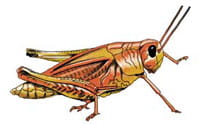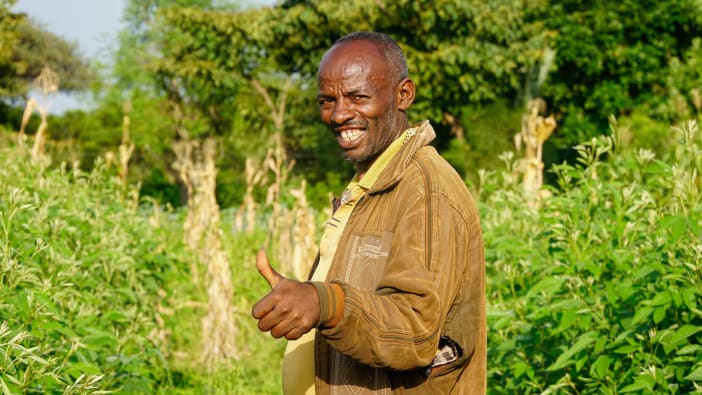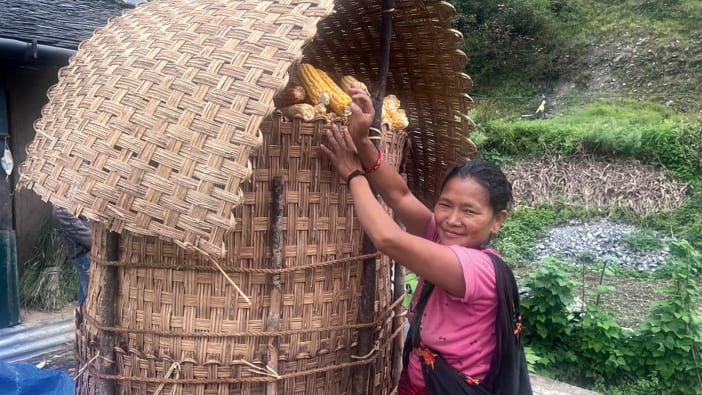A pest is an insect or animal which causes damage to a plant or crop. It is possible for an insect or animal to be a pest in one situation and beneficial in another. Pests come in all shapes and sizes. Here are some of the common pests and the problems they cause:
- Borers that weaken the plant such as termites and stem-borer in maize
- Aphids which pierce the leaf or stem and suck the sap, weakening the plant and spreading disease
- Beetles, weevils and caterpillars which eat leaves. (It is important, however, to remember that butterflies are useful for pollination.)
- Grasshoppers and locusts which bite the top of seedlings
- Larger animal pests such as monkeys, rats and birds (for example pigeons and crows) that eat seeds and plants.
Learning about pests
Before deciding which pest control method to use, it is important to learn about the pest. It would be a mistake to waste time and money controlling an insect or animal when it is not even bothering the plant.
- Identify the pest For example, if there are holes in leaves, go to the plant at different times of day and night to see if you can find the pest in action. It can be helpful to talk to neighbours and local farmers to find out what pests are common locally.
- Learn about the pest Learn about its life cycle, food and natural enemies. Often there is a stage of the life cycle at which it is easier to control the pest, such as getting rid of eggs before the insects hatch. A pest can be controlled by removing its food source or introducing natural enemies (predators). To obtain this information, talk to local farmers and extension workers or see if there are books in a local library.
- Monitor the behaviour of the pest Does the pest appear on a seasonal basis? Can it be found all over the plant or crop or only in certain places? Is the pest increasing or decreasing in number?
- Decide when to take action Remember that all insects are part of the natural environment and we should try not to disturb the natural balance unless it is necessary. It is only worth investing money in pest control if the cost of damage by the pest is greater than the cost of controlling it.
- Evaluate the effect After a natural pest control method is used, evaluate its effect. Will you use this method again for this pest or should another be tried? Did the method affect other insects? Was that a good thing or a bad thing?
Natural pest controls
PLANTS
- Companion planting is an effective way of controlling pests. It involves arranging different plants in alternate rows. For example, if melons are planted next to radishes, beetles will not move between rows of melons because they do not like the taste of radishes.
- Certain plants can be used to deter pests. For example, onions or garlic planted around the crop will discourage insects because they do not like the smell.
PREDATORS
- BIRDS Some birds eat insect pests. Birds can be attracted to a location by putting out bird seed or growing plants that produce seeds that birds like to eat but which are not useful to the farmer.
- ANIMALS The majority of small animals eat insects and other pests. For example, toads can eat thousands of insects each month, including cutworms, slugs, ants and caterpillars. Spiders eat many insect pests and snakes eat rodents. These small animals can be attracted by growing plants that they like to eat or providing natural shelter which protects them from other predators.
- INSECTS Some insects make good predators because they eat other insects. A good example of this is the ladybird. Ladybirds only eat aphids, such as greenfly and blackfly, and do not eat beneficial insects. They can eat 40–50 aphids per day and their larvae can eat even more. Insect predators can be encouraged by planting certain plants or flowers nearby which they benefit from.
NATURAL PESTICIDES
It is possible to create pesticides using natural ingredients. For example, caterpillars and aphids can be controlled using a papaya leaf spray. To make the spray:
- Shred 1kg of fresh leaves and soak in ten litres of water, together with two tablespoons of kerosene and some soap.
- Leave to stand for at least two hours (or overnight).
- Remove the leaves and use the spray immediately.
More ideas for natural pesticides can be found in Footsteps 54.
MECHANICAL CONTROLS
Mechanical pest controls are very simple to put into practice. They can include:
- Picking larger insects off the plant by hand. This is effective in small plots before the pest breeds, but is not a practical solution in large fields.
- Erecting barriers to protect plants, such as netting to stop birds pecking and covering fruit to protect it from fruit flies.
- Using traps such as rodent traps, sticky traps for insects or snail and slug traps (made from a yeast and water mixture).










